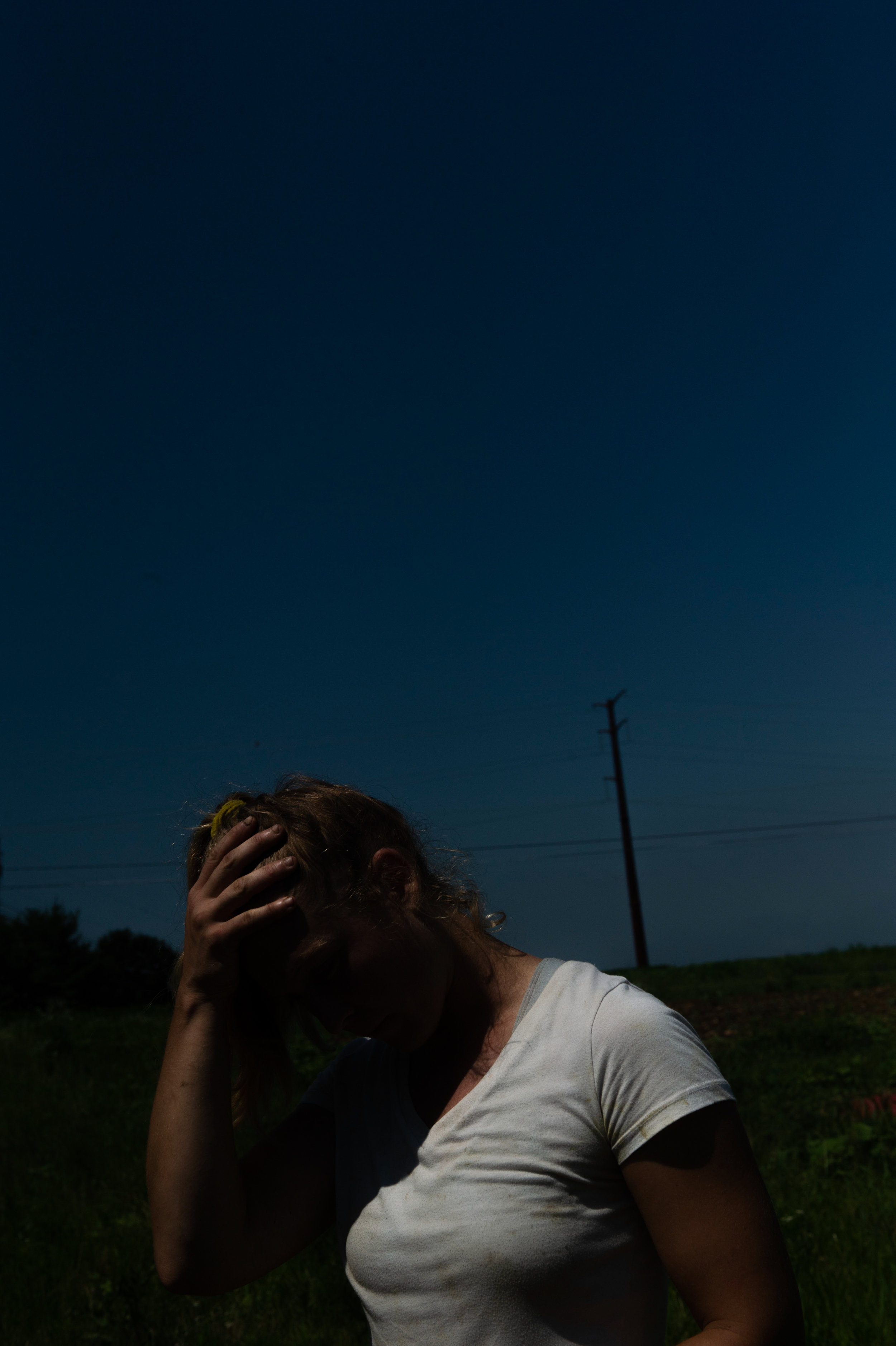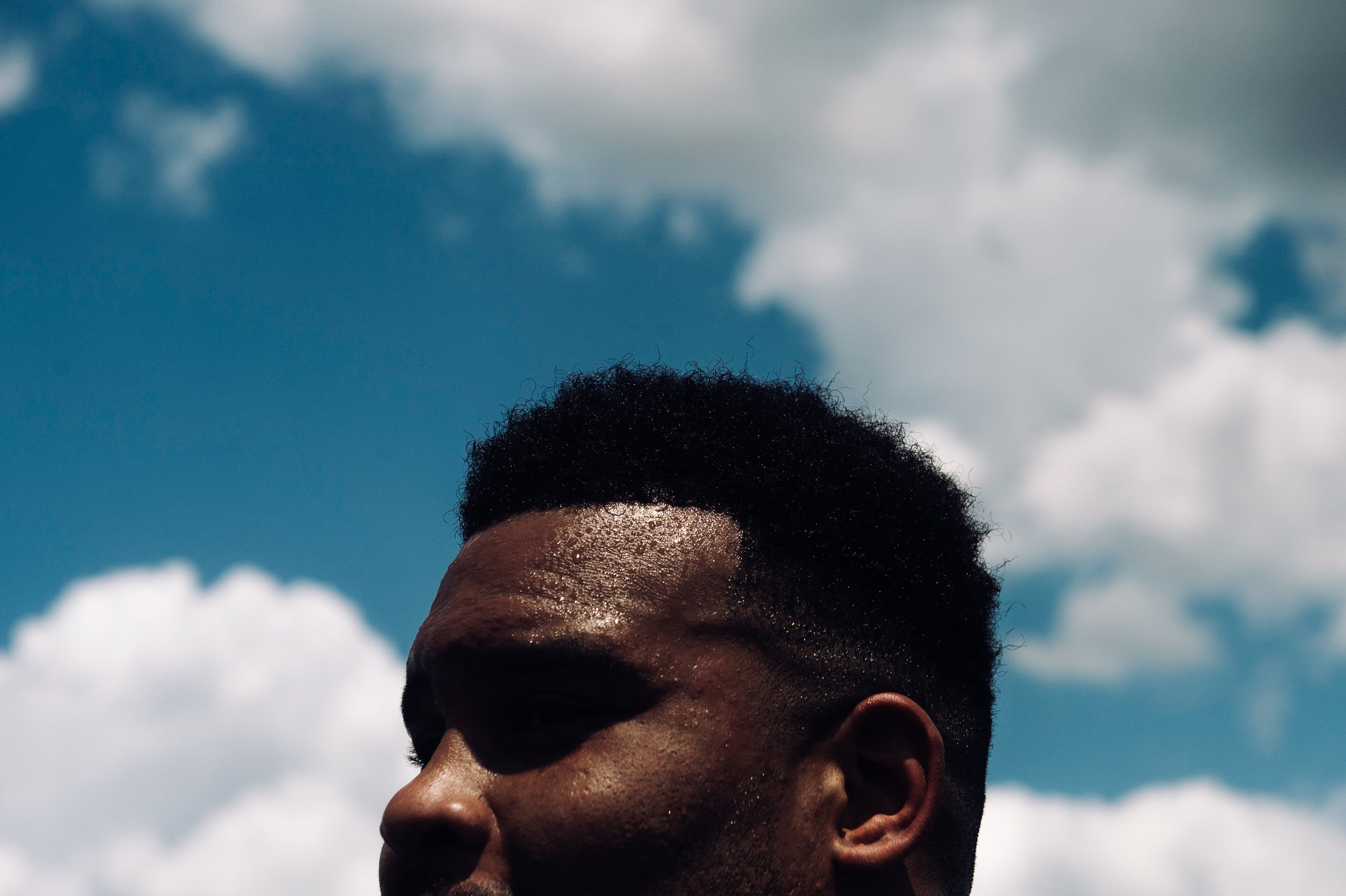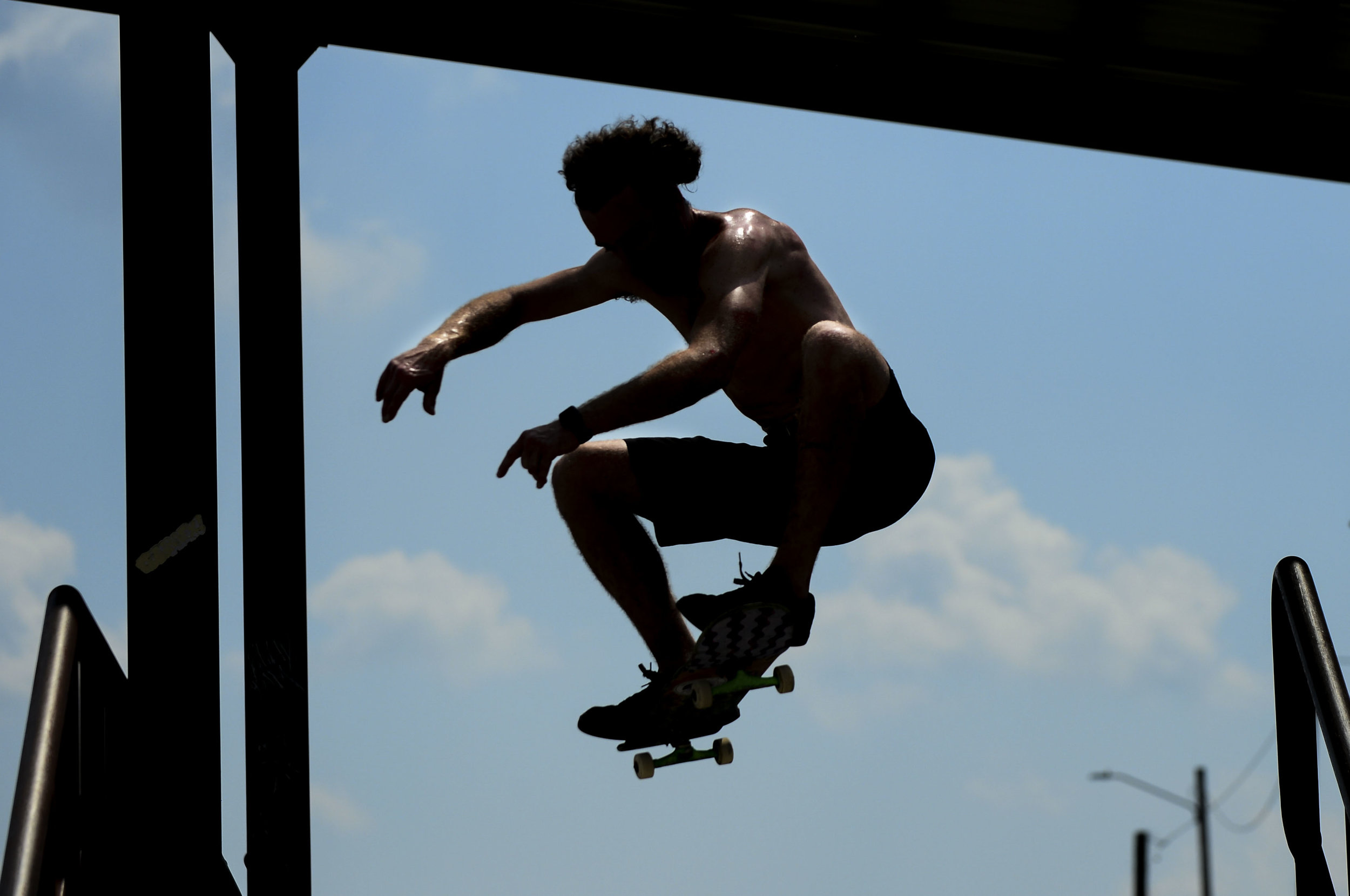SEPTEMBER 6, 2019
KRISTEN HARRISON: PRINTING 360 PERSPECTIVES
STORY BY TARA ENG / PHOTOGRAPHY BY ZACH CERCONE / EDITED BY MAE MCDERMOTT AND ERIN SHUSTER
Kristen Harrison photographs theater professor Kathleen Mulligan for The Ithacan. (Zach Cercone / Stillwater Magazine)
Though Kristen Harrison (‘20) has long-abandoned Picnik, the popular photo editing tool that originally piqued her interest in photography, Kristen’s eye for aesthetics has carried her to pursue a career in photojournalism and fine-art photography. Kristen is a photo editor of The Ithacan and a former staff photographer for The Morning Call, the newspaper of Pennsylvania’s Lehigh Valley. She has previously worked as an assistant editor for the feature documentary Her Earth, and at Insignia Films in New York City. This week, Kristen sat down with Stillwater’s co-editor-in-chief, Tara Eng, to discuss the liberties and restraints of taking a fine arts approach to photojournalism.
TE: To begin broadly, as a photojournalist, you’re put on assignment to cover a story, but you’re looking to do more than just snap a few photos and memorialize faces. What do you think photojournalism captures?
KH: As a photographer, you have to decide what you have to say about a subject without using words. You want to be able to really emphasize something to someone who has never read the story. You want to tell them what it's about, with a photo and a little caption. I mean, I'm not really good with words, as you will probably be able to tell during this interview [laughing]. That’s why I like photography.
TE: Print journalism, especially weekly or daily papers, tends to be very formulaic. Of course it has to be that way when you're publishing papers that often, but you’ve approached that formula with your own artistry – particularly with the work you’ve shot for The Morning Call and The Ithacan. Could you speak a little bit to the main question of this campaign, which is, “How do you use fine art to disrupt spaces in stasis?”
KH: At The Morning Call, some of my favorite photos that I took out on assignment were the ones that I didn't give my editor, just because they were a little more creative. I’d give her some, but I wouldn’t give her all of it. We had this conversation about how newspapers these days have shifted from having a full page spread of photos, where you could include that creative work, as opposed to now when there's one box and one space to fill. It’s put a restraint on what goes in the paper; there aren’t a lot of visual opportunities. There's a lot of photography these days that looks good but it all looks the same. You have to illustrate the story with one photo and also be creative about it, so I try to think of new ways to illustrate things.
“Andre Reed, the famous basketball player, has a yearly golf tournament to raise money for charity, and this was before the event started. All these players were kind of warming up, and I just thought it was kind of funny how all these people were in one place just practicing at the same time. And this was one of those things that like, I was waiting for the event to start and looking for things to photograph. I didn't give this one to my editor because I did some post work on this later. I wanted to get all of the shadows on the green and make it look more artistic and painterly. So I did do some post work and bring those shadows down.” (Kristen Harrison / The Morning Call)
“This is Hannah Connor, a 28 year-old farmer. I had an assignment for The Morning Call where I went with the reporter, and we just followed her around. She gave us a tour of the farm, but it was just so goddamn hot this day – I think it was like 95 degrees. This photo isn’t only darker in a more visual sense, but it shows that she does tough work.” (Kristen Harrison / The Morning Call)
TE: That reminds me, last year you were talking about shooting a double exposure to put in The Ithacan. Which, I don't think I've ever seen that in the paper before. It’s usually typical for papers to just take a headshot of someone and print that.
KH: The story was about this online publication called Growing Roots, and I thought, “Okay, how can we do more than just take headshots of these people?” It was a nature magazine, so, I thought we could do some sort of juxtaposition with flowers and overlay the photos. If I did a headshot in front of a wall, that could really be anything in the world. You really have to be intentional about how you want to communicate what you're trying to say about a subject. And that comes with [considering], what is their environment? It's not just pulling them aside and saying "Hello, can I take a picture of you?" It's asking them questions like, "What's this magazine about? What do you think it's illustrating?" And having that collaboration with your subject as well.
Amy Kruzan for Growing Roots magazine. (Kristen Harrison / The Ithacan)
Eunice Grande for Growing Roots magazine. (Kristen Harrison / The Ithacan)
It also comes with working with a design team who's open to doing that. We can't do that for every box that we have [in the paper] because we have set spaces for it, but the design team was open to play around with it a little bit more.
TE: Something I notice about your work is that you always cover events holistically – as in, you always look for these individualized threads that aren’t necessarily the “main event.” If you’re shooting a wedding, for example, the attention is on the bride and groom. But you still have these other photographs that show these tender relationships between the older adults and kids of this family.
KH: I just think that you have to shoot everything when you shoot something. And shooting 360 is really how I think I disrupt what you might expect to see....[Shooting 360] is something every photographer should learn. It’s easier at a wedding where you have more time, like, I remember being at the reception for 3 hours and just looking for what else I could shoot. It's harder when you have 20 minutes to shoot something, but it really just is looking at events as a whole.
“Towards the end of the night, everyone was up and dancing. Not just the kids.” © Kristen Harrison Photography
That's what we're trying to teach a lot of our staff photographers at The Ithacan. A lot of them do take very nice photos, but if we ask for a photo of a food pantry, per say, and they come back with a photo of the director in front of the food pantry, it's like, "Okay, well, what else is in this space?" It's a shift in how people approach these situations and how they look at it. It's hard to teach that.
TE: A shift in approach from what to what?
KH: A shift from this formulaic idea of going in knowing what you’re shooting. Moving towards a different way of thinking, really – like the ability to think outside the box and take risks with what you're photographing. A want to do more than just “taking a portrait,” I suppose.
“This is the Philadelphia Eagles player, Brandon Brooks – he was actually giving an interview. I went to the Eagles training camp; I got there, realized that I only had twenty minutes to shoot on the field, and then after practice, everyone is trying to scramble for whatever they can get with whoever wants to talk. Brooks had stepped aside for an interview. And, you see those normal interview shots of the reporters asking the question and the player’s in the middle, but this was a really good opportunity to be up close with someone, and really photograph them. I did want to show the sweat on his face, so I did intentionally underexpose that.” (Kristen Harrison / The Ithacan)
TE: Just for redundancy's sake, can you talk about what it means to shoot 360?
KH: Shooting 360 is shooting everything that what you're photographing has to offer. If you're shooting a sports game, that's not only the athletes, that's the crowd, the cheerleaders, the people working the game. We see it a lot with sports games. Even though it might not seem like what someone has asked for, it's shooting it anyway. If there's an assignment and someone says, "Go photograph this pottery class," it's like, "Well, who is at the door of this pottery class?" Things like that. If you're shooting a concert, it might be the guy in the shadows, and so on.
'“One of my cousins asked me to photograph a party for the other side of her family. This was another instance where I had a lot of time – the party was going on for hours – so I was looking for what else to shoot. Towards the end of the day, I guess the kids wanted to take a break, so they retreated outside. I liked the framing of the window and the reflection here.” © Kristen Harrison Photography
TE: Well, in the same way that a double exposed headshot allows us to reimagine how we view the people that we’re reading about, I’d say that 360 coverage allows us to reimagine our perceptions of the events that are being covered. A great example of that is one of the photos you submitted for your creative artifact – this one from the Bethlehem Music Festival.
KH: Yeah, and I don't know if other people like that photo, but I like that photo. That might not be the most visually beautiful photograph, but....as I said before, there’s so much photography today that looks the same. With this photo, I saw the different layers to this stage, with this guy kneeling down, and I saw the shadows of the other photographers in the pit....Photographing things like that [has] pushed me completely out of my comfort zone.
Photographers and workers await the next performance at the 2019 Bethlehem Musikfest. (Kristen Harrison / The Morning Call)
TE: As a photographer approaching a more rigid space, do you find yourself struggling to balance an artistic approach within the bounds of prescribed journalistic rules? Not to undermine those at all, since the integrity of journalism is drawn from those.
KH: Sometimes the most creative things don’t always illustrate it the best. At The Morning Call, I liked my work that went into the paper, but sometimes I was also just capturing an event, or capturing a sport. I found it difficult to do both sometimes, like give my editor that one photo that perfectly explained everything about the story while also having it be an avant-garde photo. It's finding the balance of both.
At The Ithacan, it's a lot harder in our news section. Going back to shooting 360, let’s say there’s an assignment to shoot a speaker who comes to campus. Even if you shoot that whole event 360, what the writer is going to ask for is a photo of the speaker. Those assignments are the most challenging because you have much less opportunity [for artistry]. You can always try and get different angles or things like that, but shooting events in dark rooms that are just one person speaking at a podium makes it difficult to create truly engaging photos. That's not to say you can't work in spaces like that. In those instances, it’s important to just have a good, well-exposed photo.
TE: How do you approach those specific events?
KH: Moving my feet. Going anywhere that I can go, really. I see a lot of new photographers just standing in one place all the time. If you can't think creatively, keep moving around. If you get stuck, keep moving wherever you have access to. I also like to shoot through people so that you can see the people and the speaker. I try to think in terms of where I don’t have to stick to that formula of only shooting the speaker. Editors might not use the photo that we like, but the best we can do is give them the option to.
Republican U.S. representative Tom Reed speaks at Ithaca College. (Kristen Harrison / The Ithacan)
TE: Do you find that collaborative relationship limiting?
KH: Well, I think I’m always going to take photos like this. Even though the photo editors pick the photos to go in the paper, the editor-in-chief can change it. Standing up for your work and what you would like to see in the paper.…it's hard. In daily news or a local paper, it’s somewhat dependent on the writers, reporters, and editors to choose stories that have what may be engaging visuals in mind. Because of that, I don’t think I’d want to stay in local news forever.
“We just did this series where we took athletes into the studio and did silhouettes of them with their gear, but they ended up not being used. I think you have to stand up for your work and push a little bit, but also know that there’s a place for it.” (Kristen Harrison / The Ithacan)
(Kristen Harrison / The Ithacan)
For example, there’s a lot of really good photographers in Washington right now who photograph Trump at any sort of press briefing that he has, and there's a lot of close photos of, like, his hairline, but it’s beautifully lit and shadowed. Or maybe they photograph the back of him and to get the crowds on the other side. On this level, you have outlets like The New York Times that let their photographers shoot freely. They’re more open to publishing photos that don’t exactly subscribe to what the story is about, and as a reader, you view the subject matter differently.
“Concerts are fun to play around with. If you have a zoom lens on, you zoom in and out a little bit and it makes it a little jerky.” (Kristen Harrison / Ithaca Underground)
(Kristen Harrison / Ithaca Underground)
“I feel like a daily paper wouldn’t post this, but an outlet like the New York Times or the Washington Post would.” (Kristen Harrison / Ithaca Underground)
On the other hand, when I was at The Morning Call, sometimes I went with a reporter to cover stories and we’d go back and forth taking charge of that. Sometimes the reporter would only ask one question, and then I would have reign of the room. Other times I’d ask the reporter, like, "What are you writing about? What's your main focus?" and that could help guide what I chose to shoot.
There was one reporter who was interviewing mothers who had lost sons to gun violence. They would sit down at a couch or a table, and it was my job to take photos of that woman in an interview setting, but not really make it look like it's an interview. That was kind of the reporter's time, and I was in the background, but later she would show us around the house. That was when the reporter stepped back, and it was my time to step forward.
“This is Shalon Buskirk, she was one of the women who had lost her son to gun violence. Here she's speaking to the reporter; she's in the interview. It was basically at her dining room table, so I was looking for different ways to photograph her. I saw that she had the light in the background, so ultimately she would be backlit. This summer I liked playing a lot with silhouettes. I like experimenting with it.” (Kristen Harrison / The Morning Call)
TE: Obviously, with the series you submitted as your creative artifact, there's a big emphasis on shadows. What interests me is that you submitted this as a set, regardless of the fact that these photos were all shot on different assignments at different times. Still, the commonalities are striking.
KH: Honestly, even though you try to shoot creatively all the time, sometimes you get stuck in this rut of, "What is my editor going to want?" And so these were kind of for me, I think. I wouldn't say this was a "project," but these photos were ways that I felt like I had creative control over my work, and it was mine. That's why sometimes I didn't submit them to my editor at The Morning Call, because I like them a lot, and I didn't know if other people would. But then I started seeing this theme, and I think I just liked being a little more outside the box with this sort of documentary work.











